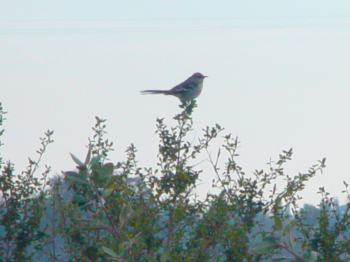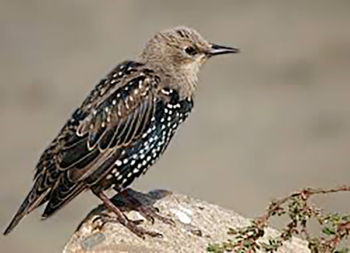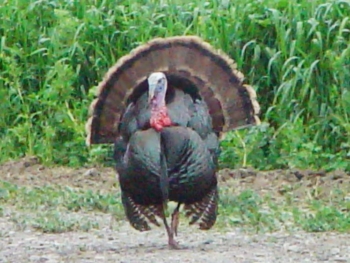Beneficial and Pest Birds: Vertebrate IPM Tip sheet
Vertebrate Integrated Pest Management Series

Feeding insects to a chick. Photo: flickr
By Martin Guerena, NCAT Agriculture Specialist
Introduction
Birds, similar to insects, can be beneficial or be pests to farmers. Beneficial birds can help reduce insects, weeds, or rodent pests that feed on and destroy crops. Pest birds, on the other hand, can damage and destroy seed, vegetable, fruit, and vine crops, causing significant economic losses. They can also be vectors of disease that can threaten the poultry industry, or they can spread E. coli, Campylobacter spp., and Salmonella spp. in fruits and vegetables. Pest birds also consume and contaminate livestock and dairy feed (Medhanie et al., 2014). Sometimes, the same birds can be beneficial by consuming insects in the spring but then become pests in the fall when they consume vegetation, fruits, and seeds.
Farmers and pest-control professionals need to identify the beneficial and pest birds, and be able to manage or manipulate those birds that shift from beneficial to pest. This tip sheet was developed to help achieve those goals.
Bird Identification
The first step in any integrated pest management strategy is to identify the pest. In the case of birds, identification is critical in order to determine whether the birds are pest, beneficial, or both. The following websites can help with correct identification:
The Cornell Lab of Ornithology, All About Birds
The Cornell Lab of Ornithology, Merlin Bird ID App (ideal for smart phones)
Audubon Guide to North American Birds
Before any action against birds is carried out, be aware of the Migratory Bird Treaty Act (MBTA) that protects all native birds from harassment or harm, except by permit. There is an exception in which one can take native birds without a permit if they will cause harm to crops or livestock. Check with the U.S. Fish and Wildlife Service, or with your local agricultural commissioner, for more information. Non-native birds not protected by MBTA include European Starlings, Pigeons, and House Sparrows.
Creating Habitat for Birds on Farms

Bird resting on a hedge. Photo: Rex Dufour, NCAT
Sustainable agriculture relies on biodiversity to provide the environmental services on which it depends to maintain productivity. Biodiversity is created by establishing habitat on the farm that harnesses the diversity of wildlife, including birds. Several types of effective habitat can be created or enhanced on agricultural land that can increase beneficial bird populations and provide pest-control services (Garfinkel and Johnson, 2015):
Hedgerows of native plants around edges of farms provide habitat for birds, as well as attracting beneficial insects, reducing weeds, reducing soil erosion, and improving water quality. Perennial grasses provide cover for ground-feeding birds, flowering plants attract insectivores and nectar-feeding birds, woody shrubs are good for roosting, and bigger trees provide bird nesting sites and serve as perches for raptors such as hawks.
-
- Windbreaks provide nesting and brood-rearing habitat, potential food, protection from wind and adverse weather, escape cover, and refuge for many species of birds. Windbreaks may provide travel corridors that facilitate movement of animals between other habitats. They are used as resting stops by migratory birds (Natural Resources Conservation Service, 2004). Windbreak species should be, ideally, native tree and shrub species suitable for the soils in your area.
- Riparian corridors are the most productive habitat for birds because of their ability to serve a large area that transects many farms and converges with many different land uses. Riparian habitats provide water, food, nesting sites, resting areas during migration, and overwintering sites.
- Surrounding landscape may add to the diversity and numbers of birds and their pest-control abilities. There is evidence that increasing natural habitat in landscapes dominated by temperate annual crops also increases biological control (Thies and Tscharntke, 1999).
- Marginal land can be made useful by planting native grasses and shrubs on it that can reduce erosion, improve water quality, and provide habitat for insects and birds.
- Cover crops increase the number of insects and allow birds to rest and forage during migrations. Many agricultural landscapes lack habitat, and cover crop fields may also be important areas providing shelter and forage for resident birds.
- Intercropping—such as planting sunflower rows along with vegetables—can increase insectivorous birds and the foraging of insects without damaging the crop (Jones and Sieving, 2006).
- Ponds and ditches can be managed to attract birds and other wildlife. Keeping the margins of ponds, ditches, and reservoirs well vegetated can improve the value of these wetland habitats for birds like egrets and herons and can improve water quality.
- Fallow fields and crop rotation are good ways to provide cover for wildlife. Leaving a recently cropped field to idle for a period will encourage birds to forage and nest in the area. Rotating different crops will reduce pests and diseases and provide a variety of insects and plants for birds to feed on.
- Brush piles provide cover for ground-nesting birds, but beware that they also may encourage squirrels and rabbits. Having the piles on farm edges or close to waterways will be more suitable for nesting, because birds would not be as exposed to predators as they are when nesting in an isolated pile.
- Fallen or dead-standing trees provide valuable habitat for birds and other animals. Cavity-nesting birds can make use of the hollows. Insects that break down the fallen tree serve as food, and fallen limbs provide cover. Limbs can also serve as perches for raptors, and lower limbs can provide sites for songbirds to prey on insects.
- Nest boxes must be constructed for the particular bird you desire to attract to your farm. Box size, height from the ground, and entrance-hole diameter are all important in attracting the desired species (See Appendix). Having the right bird house will help in excluding unwanted pest birds like starlings and sparrows.

A starling. Photo: wikimedia
Management of Pest Birds
Scouting the crop when it’s immature will help determine at what stage of maturation the crop is susceptible, and which birds are causing damage. The best time of day to look for birds is in the early morning or just before dusk in the evening. When problem birds are first detected, a treatment strategy should be prepared and implemented depending on the species, number of birds, and type of crop. Experts recommend a combination of treatments for an effective management plan.
-
- Habitat modification consists of eliminating habitat that might attract pest birds, such as water sources, plants that serve as cover, dense trees for roosts, spilled grain from storage bins or machinery, or anything else that will attract birds to the area. Mowing weeds and grasses may keep some birds away.
- Frightening devices can be auditory or visual. Combining both can be more effective, and rotating the combinations may prevent habituation.
- — Auditory devices make noises like explosions, sirens, and distress calls. They can be effective at first, but they need to be moved around to different areas to avoid familiarization. Distress calls can be species-specific and require good-quality sound equipment. Another method, known as “benign acoustic deterrence,” uses sounds that don’t have to be loud, but whose different wavelengths interfere with bird communication.
- — Visual devices like scarecrows, reflective tape, hawk kites, owl and scary-eye balloons have limited effectiveness and have to be relocated and used in combination with sound devices to remain effective. Helikites are helium-filled balloons that are tethered and float high above the field. Helikites can hover high in the sky (200 feet) and simulate birds of prey. Lasers are a new technology being used more in berry-and cherry-growing areas of the Northwest. Their effectiveness varies with daylight intensity, depending on how powerful they are. Because most bird pests are active during dawn and dusk, the lasers can be adjusted to wavelengths and frequencies that specific birds don’t like. There are robots available in the market that manually move the laser toward the birds. Drones with GPS are in development that look like raptors in flight and emit predatory bird calls, as well as distress cries.
-
-

A turkey. Photo: Rex Dufour, NCAT
Predators can be effective based on birds’ natural fear of hawks and falcons. Most prey birds will form a flock and flee the raptor, thus leaving the area. Producers can hire falconers to fly early mornings and late evenings, depending on the bird activity. Installing kestrel boxes may attract these predators to the farm property. Perches installed above the crops and along ditches or riparian areas can attract numerous hawks. Also, the use of dogs like border collies has been effective at airports, golf courses, and agricultural areas in keeping ground-foraging birds at bay, but this may not be effective with perched or flying birds.
- Exclusion utilizes nets, hoop houses, or floating row covers to keep birds physically away from crops. It is costly and used on high-value crops like wine grapes, blueberries, brambles, and aquaculture operations.
- Repellents are applied on crops to make the taste unpalatable to birds. They are marginally effective because of large amounts needed, and some are volatile and wear off.
- Shooting may be effective in small areas for scaring off most of the flock. Check with local authorities to determine whether permits are needed before shooting at birds.
- Nest destruction may discourage birds from using an area, but you will have to consult with local fish and game officials or county agricultural commissioners as to the legality.
- Trapping involves luring birds to a location using food, water, or decoys. There are many types of traps, so research and consult with local authorities as to which method is practical and useful in your area. Additionally, if live trapping is allowed, the target birds will then have to be euthanized.
-
Birds play a vital role in the overall functioning of various ecosystems, from nutrient cycling in soils to providing pest control on livestock and crops. Unfortunately, bird populations are declining on farmlands worldwide due to habitat losses and pesticide use (Greshko, 2018). Habitat conservation and development are critical if bird populations are to recover and provide us with their valuable services. Proper identification and the use of integrated pest management practices will prepare the farmer and pest control advisors with strategies and tools to manage birds that cause damage to a crop.
NRCS Practices Supporting Beneficial Birds
By Rex Dufour, NCAT
USDA Natural Resources Conservation Service provides financial and technical support for many conservation practices that support more diverse populations of beneficial birds. The practices listed below are funded through the Environmental Quality Incentives Program (EQIP). Additional bird-friendly practices not listed here are available under the Conservation Stewardship Program (CSP), termed “enhancements.” Visit the website to see the full list of practices.
| Hedgerow 422 | Riparian Forest Buffer 391 | |
| Conservation Cover 327 | Riparian Herbaceous Cover 390 | |
| Cover Crop 340 | Shallow Water Development and Management 646 | |
| Critical Area Planting 342 | Silvopasture 381 | |
| Cross Wind Trap Strips 589C | Structures for Wildlife 649 | |
| Early Successional Habitat Development/Management 647 | Tree/ Shrub Establishment 612 | |
| Field Border 386 | Upland Wildlife Habitat Management 645 | |
| Filter Strip 393 | Wetland Creation 658 | |
| Herbaceous Wind Barriers 603 | Wetland Enhancement 659 | |
| Land Reclamation, Currently Mined Land 544 | Wetland Restoration 657 | |
| Land Reclamation, Abandoned Mined Land 543 | Wetland Wildlife Habitat Management 644 | |
| Multi-Story Cropping 379 | Windbreak/Shelterbelt Establishment 380 | |
| Range Planting 550 | Windbreak/Shelterbelt Establishment 380 | |
| Restoring of Rare or Declining Natural Communities 643 | Windbreak/Shelterbelt Renovation 650 |
References
Garfinkel, Megan, and Matthew Johnson. Pest-removal Services Provided by Birds on Small Organic Farms in Northern California. Agriculture, Ecosystems & Environment 211 (2015): 24-31.
Greshko, Michael. 2018. Around the World, Farmland Birds Are in Steep Decline. June 1.
Jones, J.A and K.E Sieving. 2006. Intercropping sunflower in organic vegetables to augment bird predators of arthropods. Agriculture, Ecosystems & Environment. Vol. 117, Issues 2–3. November. p.171-177.
Medhanie, G.A., D.L. Pearl, S.A. McEwen, M.T. Guerin, C.M. Jardine, J. Schrock, and J.T. LeJeune. 2014. A longitudinal study of feed contamination by European starling excreta in Ohio dairy farms (2007-2008). J. Dairy. Sci. 97:5320-5238.
Natural Resources Conservation Service – South Dakota. 2004. Windbreaks/Shelterbelts as Wildlife Habitat. Job Sheet Insert 380. April.
Thies, C. and T. Scharntke. 1999. Landscape structure and biological control in agroecosystems. Science. 285, 893–895
Further Resources
Hedgerows and Farmscaping for California Agriculture: A Resource Guide for Farmers, 2nd Edition. 2018. By Sam Earnshaw. Community Alliance with Family Farmers.
National Resource Conservation Service (NRCS).
Songbird, Bat and Owl Boxes: Vineyard Management with an Eye towards Wildlife. 2008. By Emily Heaton, Rachel Long, Chuck Ingels, and Tom Hoffman. University of California, Agriculture and Natural Resources. Publication 21636.
Supporting Beneficial Birds and Managing Pest Birds. 2019. By Jo Ann Baumgartner, Sara Kross, Sacha Heath, and Shelly Connor. Wild Farm Alliance.
Appendix
| Species | Floor (Inches) | Height (Inches) | Hole Diameter (Inches) | Hole Above Floor (Inches) | Box Above Ground (Feet) |
| Chickadees | |||||
| Chickadees Titmice |
4×4 4×4 |
6-10 6-12 |
1 1/8 1 1/4 |
4-8 4-10 |
6-15 6-15 |
| Ducks | |||||
| Wood Duck | 10×18 | 10-24 | 4 | 12-16 | 6-20 |
| Flycatchers | |||||
| Ash-throated Great Crested |
6×6 6×6 |
8-12 8-12 |
1 1/2 1 3/4 |
6-10 6-10 |
5-15 5-15 |
| Falcons | |||||
| American Kestrel | 8×8 | 12-15 | 3 | 9-12 | 8-30 |
| Nuthatches | |||||
| Brown-headed, Pygmy, and Red-breasted White-breasted |
4×4 4×4 |
8-10 8-10 |
1 1/4 1 3/8 |
6-8 6-8 |
5-15 5-15 |
| Owls | |||||
| Barn Screech |
10×18 8×8 |
15-18 c |
6 3 |
4 9-12 |
12-18 8-30 |
| Phoebes | |||||
| Black, Eastern, and Say’s | 6×6 nest shelf | 6 | – | – | 8-12 |
| Swallows | |||||
| Barn Purple Martin Tree and Violet Green |
6×6 nest shelf 6×6 5×5 |
6 6 6-8 |
– 2 1/4 1 1/2 |
– 1-2 4-6 |
8-12 6-20 6-15 |
| Thrushes / Bluebirds | |||||
| Eastern Bluebird Western Bluebird Mountain Bluebird |
5×5 5×5 5×5 |
6-12 6-12 6-12 |
1 1/2 1 1/2 1 9/16 |
4-10 4-10 4-10 |
4-10 4-10 4-10 |
| Woodpeckers | |||||
| Downy Hairy Lewis’s Flicker Pileated Red-headed Yellow-bellied |
4×4 6×6 7×7 7×7 8×8 6×6 5×5 |
8-10 12-15 16-18 16-18 16-24 12-15 12-15 |
1 1/4 1 1/2 2 1/2 2 1/2 3×4 2 1 1/2 |
6-8 9-12 14-16 14-16 12-20 9-12 9-12 |
5-15 8-20 12-20 6-20 15-25 10-20 10-20 |
| Warblers | |||||
| Prothonotary | 5×5 | 6 | 1 1/8 | 4-5 | 4-8 |
| Wrens | |||||
| House Carolina Bewick’s |
4×4 4×4 4×4 |
6-8 6-8 6-8 |
1 1/8 1 1/4 1 1/8 |
4-6 4-6 4-6 |
5-10 5-10 5-10 |
Beneficial and Pest Birds: Vertebrate IPM Tip Sheet
Martin Guerena, NCAT Agriculture Specialist
Published May 2019
©NCAT
IP560
This publication is produced by the National Center for Appropriate Technology through the ATTRA Sustainable Agriculture program, under a cooperative agreement with USDA Rural Development. This publication was also made possible in part by funding from the National Institute of Food and Agriculture, U.S. Department of Agriculture, award number 2013-51106-20970. ATTRA.NCAT.ORG.


